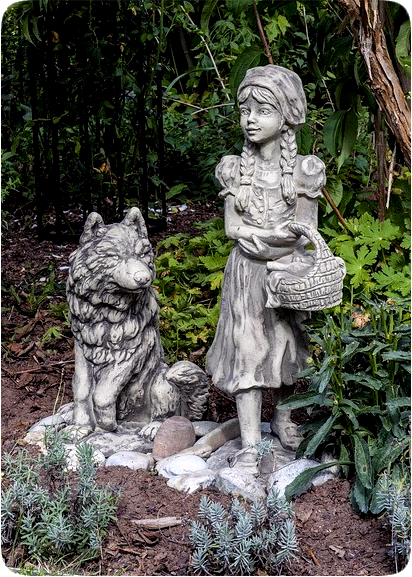The Shoemaker and the Elves
A shoemaker and his wife lived in a little house on the edge of a wood. They were very, very poor, and each day they grew poorer and poorer. At last, there was nothing left in the house but leather for one pair of shoes. “I will cut out this last pair of shoes,” the shoemaker said to his wife. “To-morrow I will sew them and peg them.” So he cut out the leather and left it on his bench.
The next morning he went into his shop to make the shoes. What did he see! A pair of shoes, all nicely made and ready to be sold. The stitches were so fine and the shoes so well made that they were quickly sold.
With the money, the poor shoemaker bought leather for two pairs of shoes. Then he said to his wife, “I will cut out the leather for two pairs of shoes. To-morrow I will sew them and peg them.” So he cut out the leather for the shoes and left it on his bench.
The next morning when he went into his shop to make the shoes, what did he find! Yes, there were two pairs of shoes already made. The work was so well done that those shoes were also sold very quickly.
With the money, the poor shoemaker bought enough leather for four pairs of shoes. Those he also cut out and left upon his bench. The next morning he found four pairs of beautiful shoes, all well made.
And so it went on and on. Instead of being a very poor shoemaker, he became a very rich shoemaker. His shoes were so well made that even the queen herself wore them.
At last, the shoemaker said to his wife, “We must find out who makes the shoes.” So one bright moonlight night they hid behind a curtain, where they could watch the bench and not be seen.
Just on the stroke of midnight, two little elves jumped through the window. They went skipping and dancing up to the bench. Sitting cross-legged, they took up the leather and began to work. How their needles flew back and forth, back and forth! How their little hammers beat: rap-a-tap-tap, rap-a-tap-tap!
Almost before the shoemaker and his wife could think, the work was all done. The tiny elves ran about, skipping and dancing, skipping and dancing. Then, whisk! quick as a wink, they were gone.
The next morning the good shoemaker said to his wife, “What can we do for those dear little elves?” “I should like very much to make some clothes for them,” said his wife. “They were almost without any.” “If you will make their coats, I will make them some shoes,” said the shoemaker. “Their little feet were bare.” When the clothes and shoes were ready, they were put upon the bench.
The shoemaker and his wife again hid behind the curtain. Just as before, when the clock struck twelve, in jumped the tiny elves. They went skipping and dancing, skipping and dancing, to their work. They saw the little coats, the tiny stockings, and the neat little shoes. They clapped their hands for joy. Then, slipping on their clothes, they skipped, hand in hand, out of the window.
The shoemaker and his wife never saw the little elves again, but after that night, good luck seemed always to be with them.
by Author Unknown: as published in James H. Fassett: “The Beacon Second Reader” (1914); type of work: English folk tale in a lesson book for schoolchildren
A shoemaker and his wife lived in a little house on the edge of a wood. They were very, very poor, and each day they grew poorer and poorer. At last, there was nothing left in the house but leather for one pair of shoes. “I will cut out this last pair of shoes,” the shoemaker said to his wife. “To-morrow I will sew them and peg them.” So he cut out the leather and left it on his bench.
The next morning he went into his shop to make the shoes. What did he see! A pair of shoes, all nicely made and ready to be sold. The stitches were so fine and the shoes so well made that they were quickly sold.
With the money, the poor shoemaker bought leather for two pairs of shoes. Then he said to his wife, “I will cut out the leather for two pairs of shoes. To-morrow I will sew them and peg them.” So he cut out the leather for the shoes and left it on his bench.
The next morning when he went into his shop to make the shoes, what did he find! Yes, there were two pairs of shoes already made. The work was so well done that those shoes were also sold very quickly.
With the money, the poor shoemaker bought enough leather for four pairs of shoes. Those he also cut out and left upon his bench. The next morning he found four pairs of beautiful shoes, all well made.
And so it went on and on. Instead of being a very poor shoemaker, he became a very rich shoemaker. His shoes were so well made that even the queen herself wore them.
At last, the shoemaker said to his wife, “We must find out who makes the shoes.” So one bright moonlight night they hid behind a curtain, where they could watch the bench and not be seen.
Just on the stroke of midnight, two little elves jumped through the window. They went skipping and dancing up to the bench. Sitting cross-legged, they took up the leather and began to work. How their needles flew back and forth, back and forth! How their little hammers beat: rap-a-tap-tap, rap-a-tap-tap!
Almost before the shoemaker and his wife could think, the work was all done. The tiny elves ran about, skipping and dancing, skipping and dancing. Then, whisk! quick as a wink, they were gone.
The next morning the good shoemaker said to his wife, “What can we do for those dear little elves?” “I should like very much to make some clothes for them,” said his wife. “They were almost without any.” “If you will make their coats, I will make them some shoes,” said the shoemaker. “Their little feet were bare.” When the clothes and shoes were ready, they were put upon the bench.
The shoemaker and his wife again hid behind the curtain. Just as before, when the clock struck twelve, in jumped the tiny elves. They went skipping and dancing, skipping and dancing, to their work. They saw the little coats, the tiny stockings, and the neat little shoes. They clapped their hands for joy. Then, slipping on their clothes, they skipped, hand in hand, out of the window.
The shoemaker and his wife never saw the little elves again, but after that night, good luck seemed always to be with them.
by Author Unknown: as published in James H. Fassett: “The Beacon Second Reader” (1914); type of work: English folk tale in a lesson book for schoolchildren




































































































